Analysis of Sainsbury's Business Environment: BUS4001 Report
VerifiedAdded on 2023/01/11
|15
|4014
|43
Report
AI Summary
This report provides a detailed analysis of Sainsbury's business environment, focusing on key aspects such as its competitive structure, stakeholder relationships, and the national economic system of the UK. The report begins with an introduction to the business environment and a brief overview of Sainsbury's. It then assesses the competitive structure using Porter's Five Forces model, evaluating the threats and opportunities within the retail industry. Following this, the report identifies and analyzes the stakeholders of Sainsbury's, examining their influence and needs. The report also explores the national economic system of the UK, discussing the advantages and disadvantages of a market economy in the context of Sainsbury's operations. The analysis includes discussions on political, economic, social, technological, legal, and environmental factors affecting Sainsbury's. The report concludes with a summary of findings and relevant references.
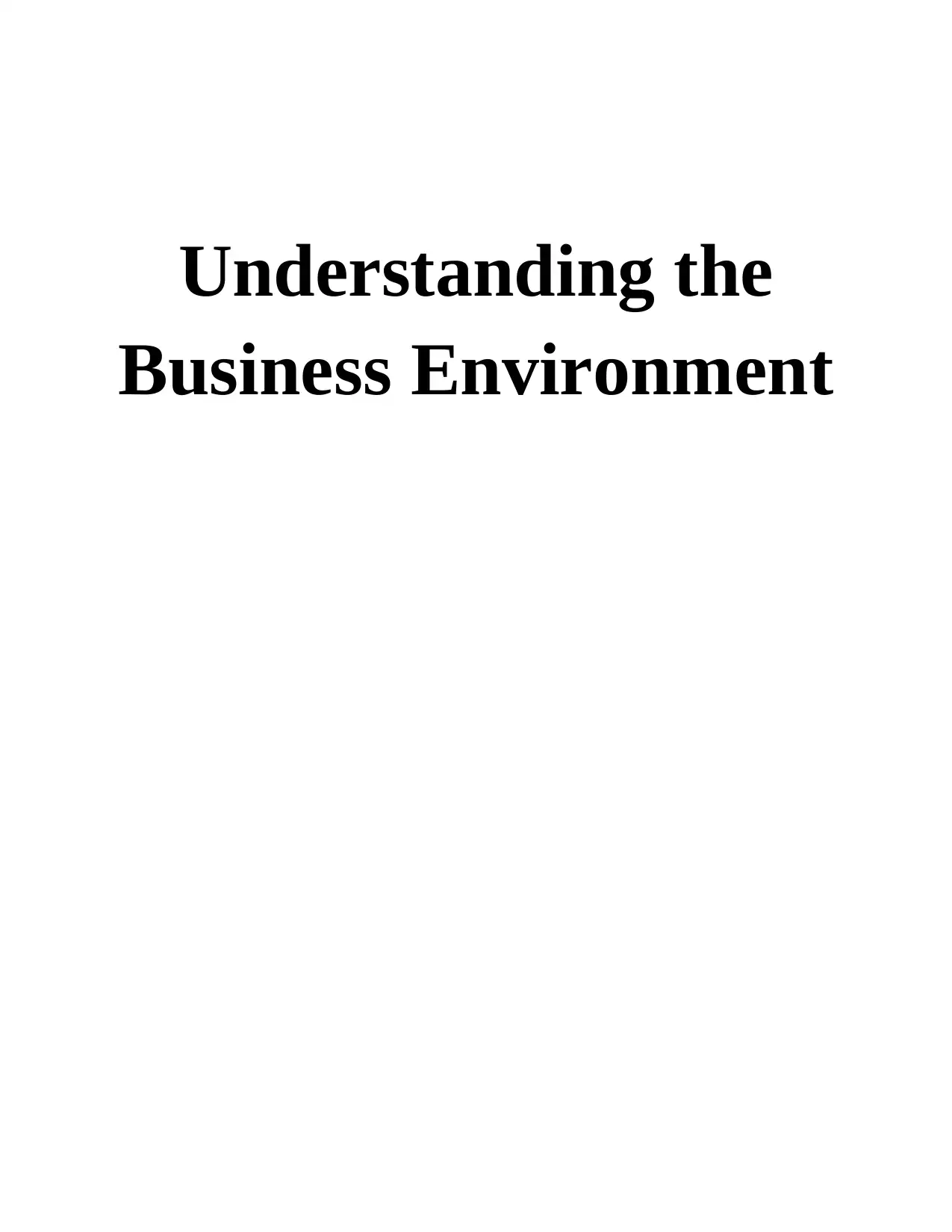
Understanding the
Business Environment
Business Environment
Paraphrase This Document
Need a fresh take? Get an instant paraphrase of this document with our AI Paraphraser
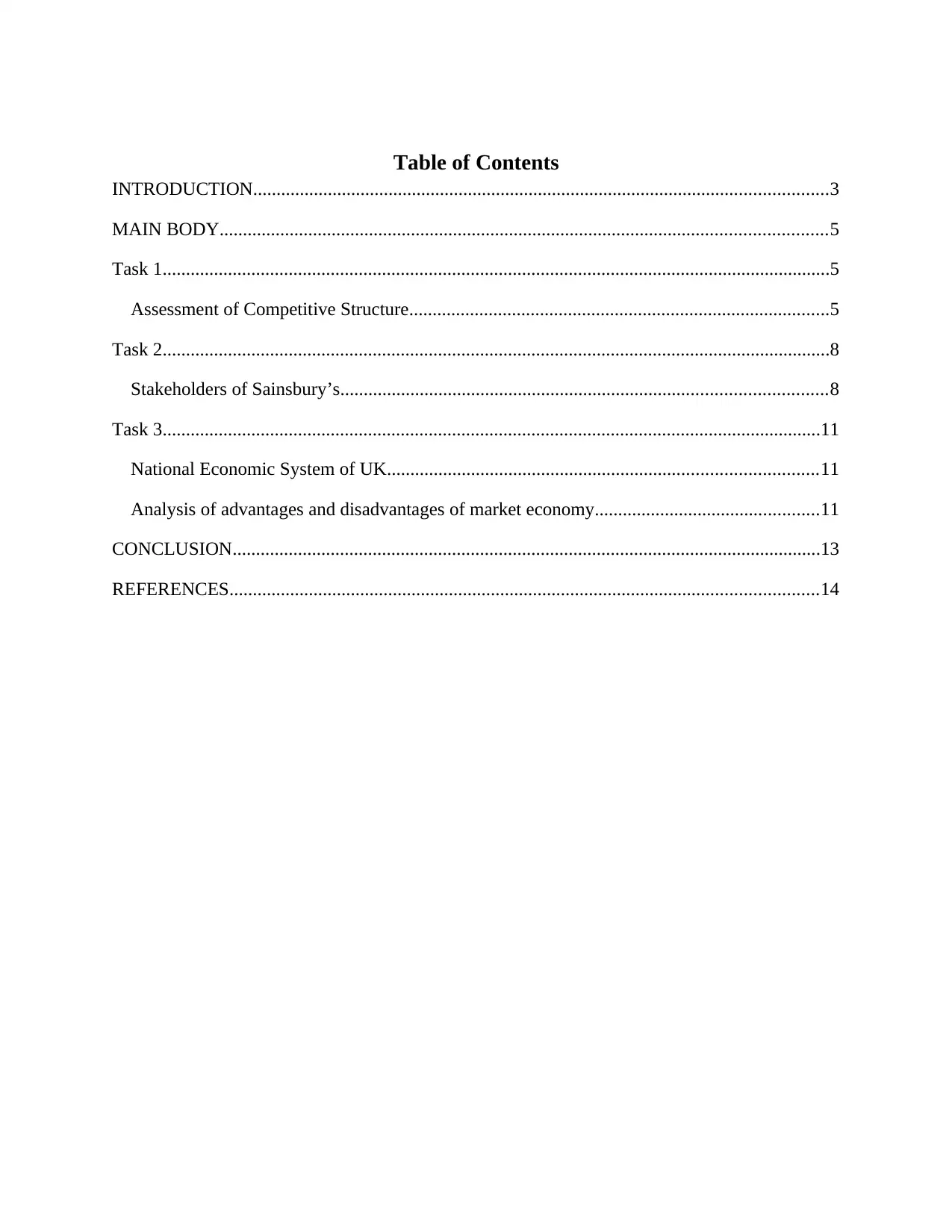
Table of Contents
INTRODUCTION...........................................................................................................................3
MAIN BODY..................................................................................................................................5
Task 1...............................................................................................................................................5
Assessment of Competitive Structure..........................................................................................5
Task 2...............................................................................................................................................8
Stakeholders of Sainsbury’s........................................................................................................8
Task 3.............................................................................................................................................11
National Economic System of UK............................................................................................11
Analysis of advantages and disadvantages of market economy................................................11
CONCLUSION..............................................................................................................................13
REFERENCES..............................................................................................................................14
INTRODUCTION...........................................................................................................................3
MAIN BODY..................................................................................................................................5
Task 1...............................................................................................................................................5
Assessment of Competitive Structure..........................................................................................5
Task 2...............................................................................................................................................8
Stakeholders of Sainsbury’s........................................................................................................8
Task 3.............................................................................................................................................11
National Economic System of UK............................................................................................11
Analysis of advantages and disadvantages of market economy................................................11
CONCLUSION..............................................................................................................................13
REFERENCES..............................................................................................................................14
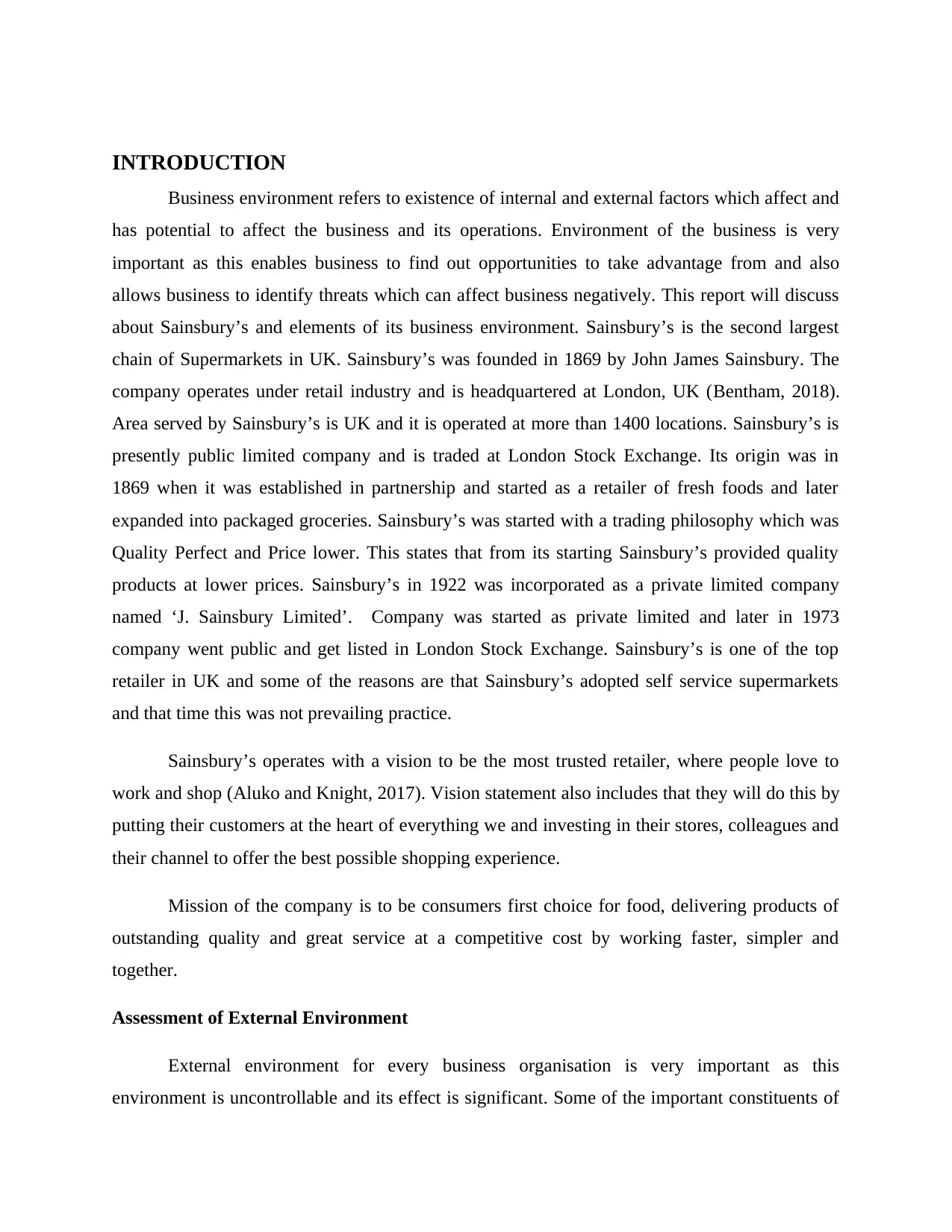
INTRODUCTION
Business environment refers to existence of internal and external factors which affect and
has potential to affect the business and its operations. Environment of the business is very
important as this enables business to find out opportunities to take advantage from and also
allows business to identify threats which can affect business negatively. This report will discuss
about Sainsbury’s and elements of its business environment. Sainsbury’s is the second largest
chain of Supermarkets in UK. Sainsbury’s was founded in 1869 by John James Sainsbury. The
company operates under retail industry and is headquartered at London, UK (Bentham, 2018).
Area served by Sainsbury’s is UK and it is operated at more than 1400 locations. Sainsbury’s is
presently public limited company and is traded at London Stock Exchange. Its origin was in
1869 when it was established in partnership and started as a retailer of fresh foods and later
expanded into packaged groceries. Sainsbury’s was started with a trading philosophy which was
Quality Perfect and Price lower. This states that from its starting Sainsbury’s provided quality
products at lower prices. Sainsbury’s in 1922 was incorporated as a private limited company
named ‘J. Sainsbury Limited’. Company was started as private limited and later in 1973
company went public and get listed in London Stock Exchange. Sainsbury’s is one of the top
retailer in UK and some of the reasons are that Sainsbury’s adopted self service supermarkets
and that time this was not prevailing practice.
Sainsbury’s operates with a vision to be the most trusted retailer, where people love to
work and shop (Aluko and Knight, 2017). Vision statement also includes that they will do this by
putting their customers at the heart of everything we and investing in their stores, colleagues and
their channel to offer the best possible shopping experience.
Mission of the company is to be consumers first choice for food, delivering products of
outstanding quality and great service at a competitive cost by working faster, simpler and
together.
Assessment of External Environment
External environment for every business organisation is very important as this
environment is uncontrollable and its effect is significant. Some of the important constituents of
Business environment refers to existence of internal and external factors which affect and
has potential to affect the business and its operations. Environment of the business is very
important as this enables business to find out opportunities to take advantage from and also
allows business to identify threats which can affect business negatively. This report will discuss
about Sainsbury’s and elements of its business environment. Sainsbury’s is the second largest
chain of Supermarkets in UK. Sainsbury’s was founded in 1869 by John James Sainsbury. The
company operates under retail industry and is headquartered at London, UK (Bentham, 2018).
Area served by Sainsbury’s is UK and it is operated at more than 1400 locations. Sainsbury’s is
presently public limited company and is traded at London Stock Exchange. Its origin was in
1869 when it was established in partnership and started as a retailer of fresh foods and later
expanded into packaged groceries. Sainsbury’s was started with a trading philosophy which was
Quality Perfect and Price lower. This states that from its starting Sainsbury’s provided quality
products at lower prices. Sainsbury’s in 1922 was incorporated as a private limited company
named ‘J. Sainsbury Limited’. Company was started as private limited and later in 1973
company went public and get listed in London Stock Exchange. Sainsbury’s is one of the top
retailer in UK and some of the reasons are that Sainsbury’s adopted self service supermarkets
and that time this was not prevailing practice.
Sainsbury’s operates with a vision to be the most trusted retailer, where people love to
work and shop (Aluko and Knight, 2017). Vision statement also includes that they will do this by
putting their customers at the heart of everything we and investing in their stores, colleagues and
their channel to offer the best possible shopping experience.
Mission of the company is to be consumers first choice for food, delivering products of
outstanding quality and great service at a competitive cost by working faster, simpler and
together.
Assessment of External Environment
External environment for every business organisation is very important as this
environment is uncontrollable and its effect is significant. Some of the important constituents of
⊘ This is a preview!⊘
Do you want full access?
Subscribe today to unlock all pages.

Trusted by 1+ million students worldwide
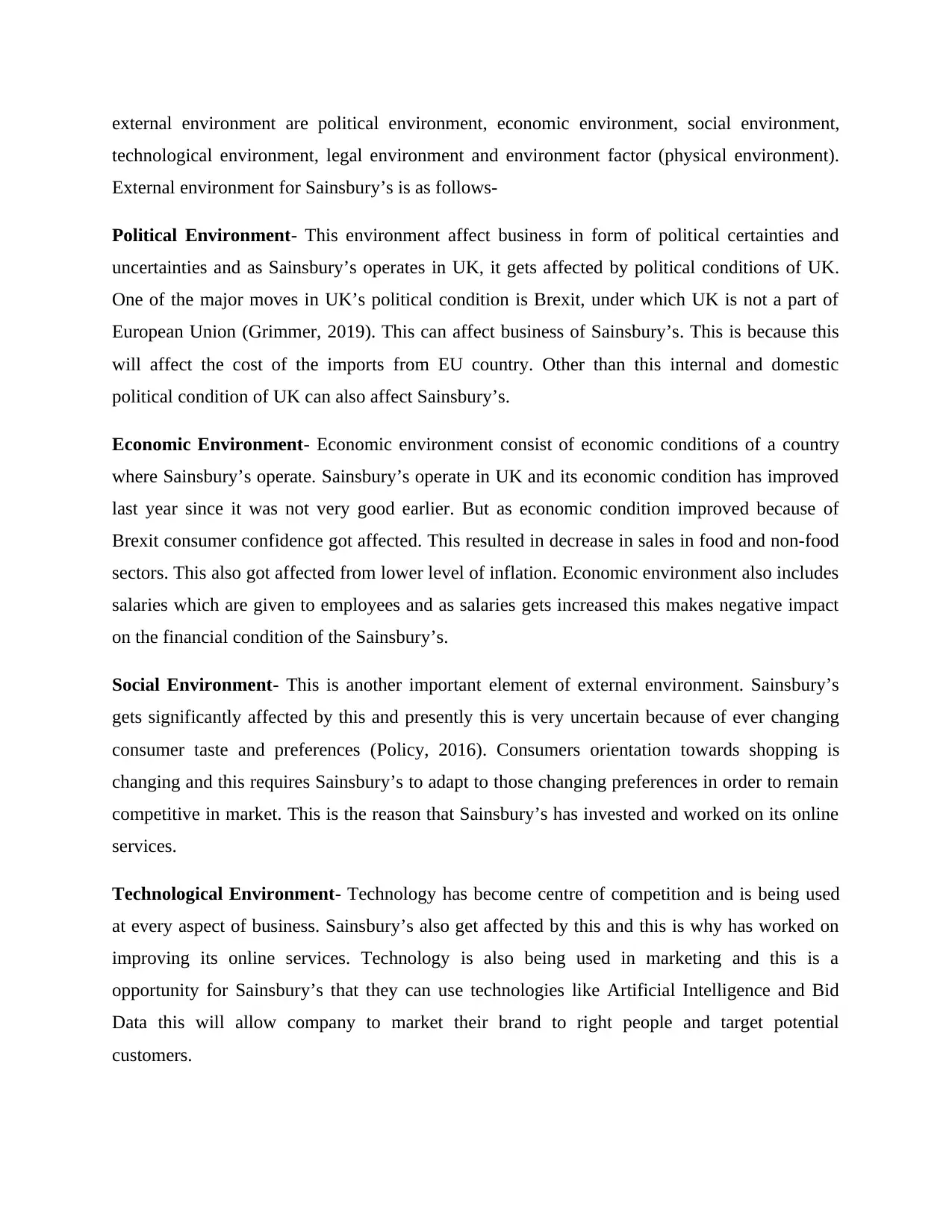
external environment are political environment, economic environment, social environment,
technological environment, legal environment and environment factor (physical environment).
External environment for Sainsbury’s is as follows-
Political Environment- This environment affect business in form of political certainties and
uncertainties and as Sainsbury’s operates in UK, it gets affected by political conditions of UK.
One of the major moves in UK’s political condition is Brexit, under which UK is not a part of
European Union (Grimmer, 2019). This can affect business of Sainsbury’s. This is because this
will affect the cost of the imports from EU country. Other than this internal and domestic
political condition of UK can also affect Sainsbury’s.
Economic Environment- Economic environment consist of economic conditions of a country
where Sainsbury’s operate. Sainsbury’s operate in UK and its economic condition has improved
last year since it was not very good earlier. But as economic condition improved because of
Brexit consumer confidence got affected. This resulted in decrease in sales in food and non-food
sectors. This also got affected from lower level of inflation. Economic environment also includes
salaries which are given to employees and as salaries gets increased this makes negative impact
on the financial condition of the Sainsbury’s.
Social Environment- This is another important element of external environment. Sainsbury’s
gets significantly affected by this and presently this is very uncertain because of ever changing
consumer taste and preferences (Policy, 2016). Consumers orientation towards shopping is
changing and this requires Sainsbury’s to adapt to those changing preferences in order to remain
competitive in market. This is the reason that Sainsbury’s has invested and worked on its online
services.
Technological Environment- Technology has become centre of competition and is being used
at every aspect of business. Sainsbury’s also get affected by this and this is why has worked on
improving its online services. Technology is also being used in marketing and this is a
opportunity for Sainsbury’s that they can use technologies like Artificial Intelligence and Bid
Data this will allow company to market their brand to right people and target potential
customers.
technological environment, legal environment and environment factor (physical environment).
External environment for Sainsbury’s is as follows-
Political Environment- This environment affect business in form of political certainties and
uncertainties and as Sainsbury’s operates in UK, it gets affected by political conditions of UK.
One of the major moves in UK’s political condition is Brexit, under which UK is not a part of
European Union (Grimmer, 2019). This can affect business of Sainsbury’s. This is because this
will affect the cost of the imports from EU country. Other than this internal and domestic
political condition of UK can also affect Sainsbury’s.
Economic Environment- Economic environment consist of economic conditions of a country
where Sainsbury’s operate. Sainsbury’s operate in UK and its economic condition has improved
last year since it was not very good earlier. But as economic condition improved because of
Brexit consumer confidence got affected. This resulted in decrease in sales in food and non-food
sectors. This also got affected from lower level of inflation. Economic environment also includes
salaries which are given to employees and as salaries gets increased this makes negative impact
on the financial condition of the Sainsbury’s.
Social Environment- This is another important element of external environment. Sainsbury’s
gets significantly affected by this and presently this is very uncertain because of ever changing
consumer taste and preferences (Policy, 2016). Consumers orientation towards shopping is
changing and this requires Sainsbury’s to adapt to those changing preferences in order to remain
competitive in market. This is the reason that Sainsbury’s has invested and worked on its online
services.
Technological Environment- Technology has become centre of competition and is being used
at every aspect of business. Sainsbury’s also get affected by this and this is why has worked on
improving its online services. Technology is also being used in marketing and this is a
opportunity for Sainsbury’s that they can use technologies like Artificial Intelligence and Bid
Data this will allow company to market their brand to right people and target potential
customers.
Paraphrase This Document
Need a fresh take? Get an instant paraphrase of this document with our AI Paraphraser
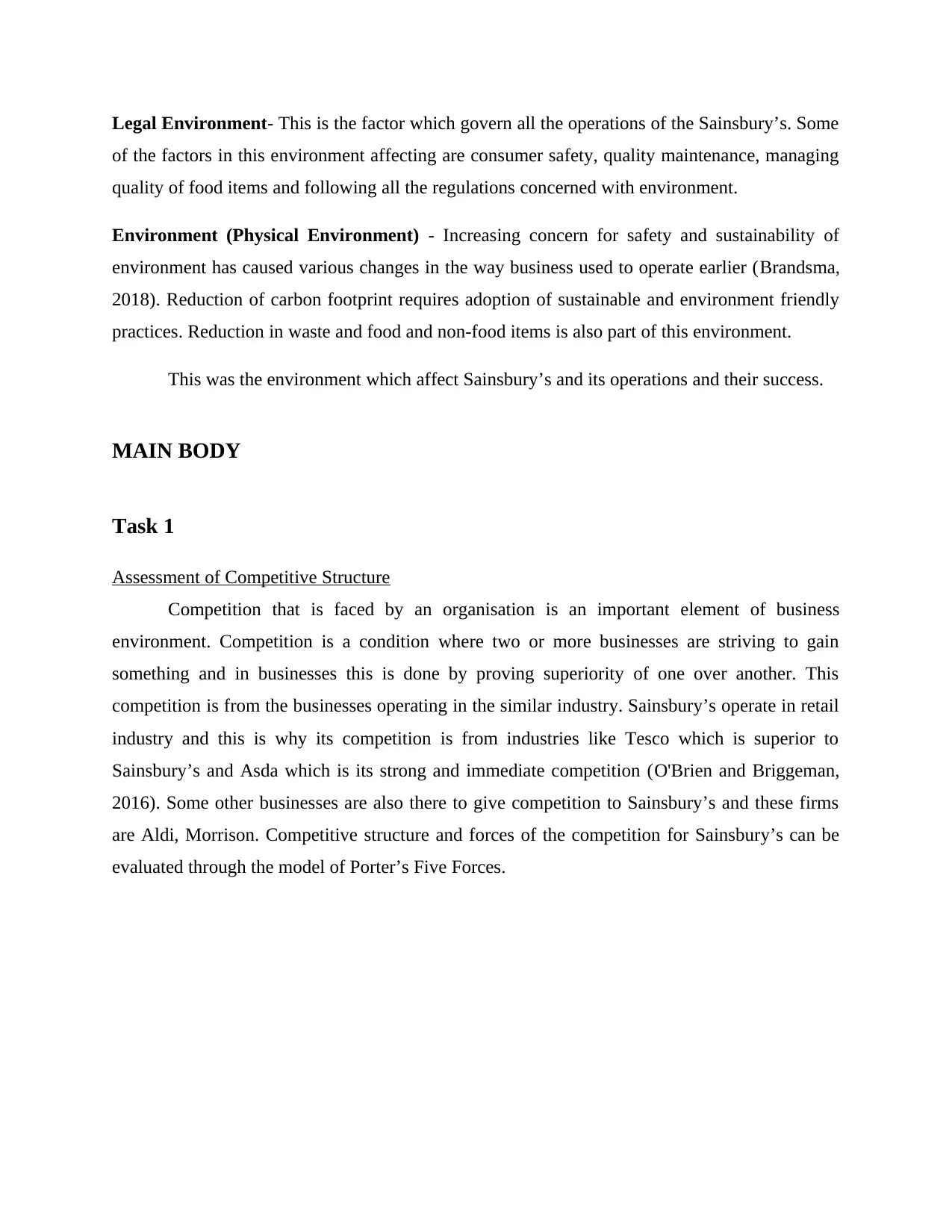
Legal Environment- This is the factor which govern all the operations of the Sainsbury’s. Some
of the factors in this environment affecting are consumer safety, quality maintenance, managing
quality of food items and following all the regulations concerned with environment.
Environment (Physical Environment) - Increasing concern for safety and sustainability of
environment has caused various changes in the way business used to operate earlier (Brandsma,
2018). Reduction of carbon footprint requires adoption of sustainable and environment friendly
practices. Reduction in waste and food and non-food items is also part of this environment.
This was the environment which affect Sainsbury’s and its operations and their success.
MAIN BODY
Task 1
Assessment of Competitive Structure
Competition that is faced by an organisation is an important element of business
environment. Competition is a condition where two or more businesses are striving to gain
something and in businesses this is done by proving superiority of one over another. This
competition is from the businesses operating in the similar industry. Sainsbury’s operate in retail
industry and this is why its competition is from industries like Tesco which is superior to
Sainsbury’s and Asda which is its strong and immediate competition (O'Brien and Briggeman,
2016). Some other businesses are also there to give competition to Sainsbury’s and these firms
are Aldi, Morrison. Competitive structure and forces of the competition for Sainsbury’s can be
evaluated through the model of Porter’s Five Forces.
of the factors in this environment affecting are consumer safety, quality maintenance, managing
quality of food items and following all the regulations concerned with environment.
Environment (Physical Environment) - Increasing concern for safety and sustainability of
environment has caused various changes in the way business used to operate earlier (Brandsma,
2018). Reduction of carbon footprint requires adoption of sustainable and environment friendly
practices. Reduction in waste and food and non-food items is also part of this environment.
This was the environment which affect Sainsbury’s and its operations and their success.
MAIN BODY
Task 1
Assessment of Competitive Structure
Competition that is faced by an organisation is an important element of business
environment. Competition is a condition where two or more businesses are striving to gain
something and in businesses this is done by proving superiority of one over another. This
competition is from the businesses operating in the similar industry. Sainsbury’s operate in retail
industry and this is why its competition is from industries like Tesco which is superior to
Sainsbury’s and Asda which is its strong and immediate competition (O'Brien and Briggeman,
2016). Some other businesses are also there to give competition to Sainsbury’s and these firms
are Aldi, Morrison. Competitive structure and forces of the competition for Sainsbury’s can be
evaluated through the model of Porter’s Five Forces.
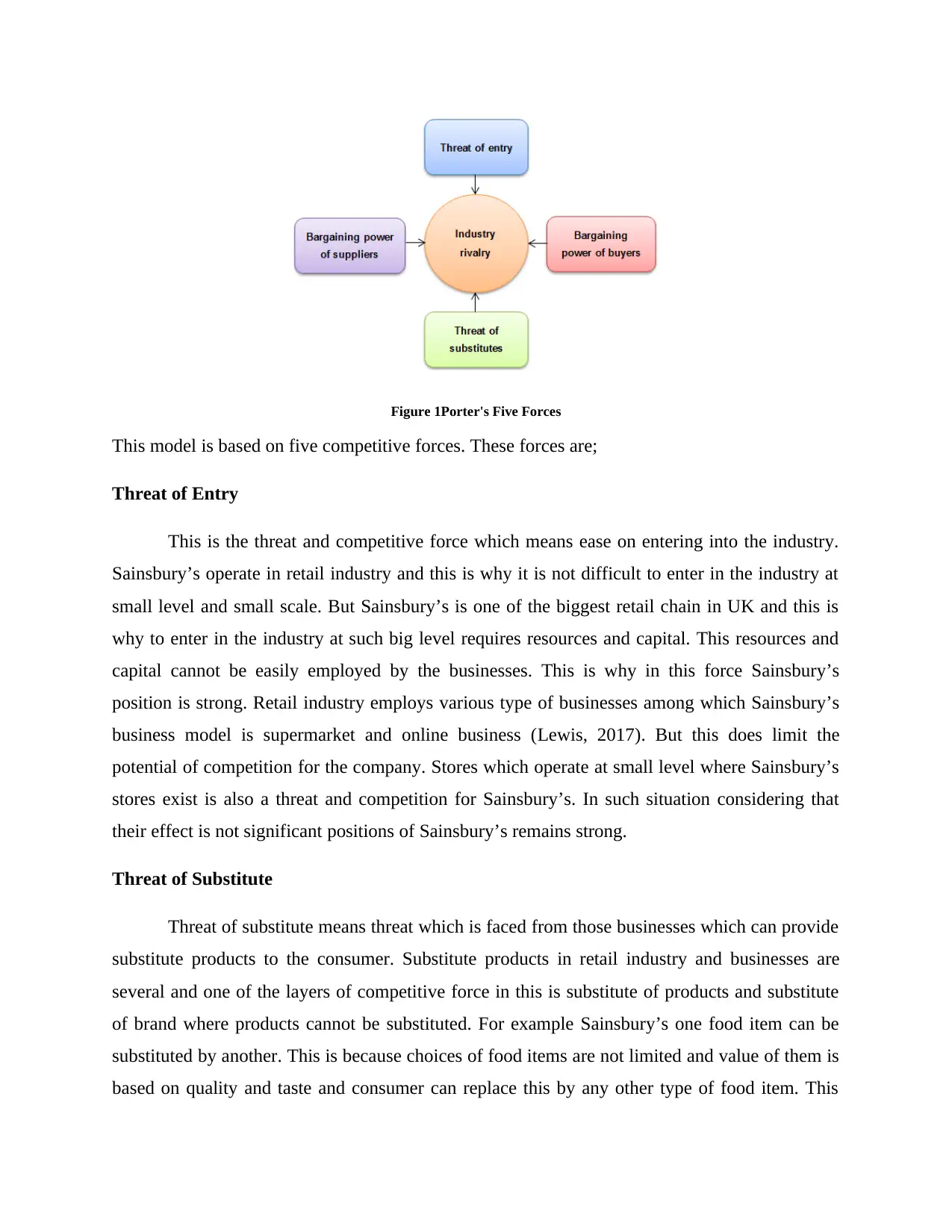
Figure 1Porter's Five Forces
This model is based on five competitive forces. These forces are;
Threat of Entry
This is the threat and competitive force which means ease on entering into the industry.
Sainsbury’s operate in retail industry and this is why it is not difficult to enter in the industry at
small level and small scale. But Sainsbury’s is one of the biggest retail chain in UK and this is
why to enter in the industry at such big level requires resources and capital. This resources and
capital cannot be easily employed by the businesses. This is why in this force Sainsbury’s
position is strong. Retail industry employs various type of businesses among which Sainsbury’s
business model is supermarket and online business (Lewis, 2017). But this does limit the
potential of competition for the company. Stores which operate at small level where Sainsbury’s
stores exist is also a threat and competition for Sainsbury’s. In such situation considering that
their effect is not significant positions of Sainsbury’s remains strong.
Threat of Substitute
Threat of substitute means threat which is faced from those businesses which can provide
substitute products to the consumer. Substitute products in retail industry and businesses are
several and one of the layers of competitive force in this is substitute of products and substitute
of brand where products cannot be substituted. For example Sainsbury’s one food item can be
substituted by another. This is because choices of food items are not limited and value of them is
based on quality and taste and consumer can replace this by any other type of food item. This
This model is based on five competitive forces. These forces are;
Threat of Entry
This is the threat and competitive force which means ease on entering into the industry.
Sainsbury’s operate in retail industry and this is why it is not difficult to enter in the industry at
small level and small scale. But Sainsbury’s is one of the biggest retail chain in UK and this is
why to enter in the industry at such big level requires resources and capital. This resources and
capital cannot be easily employed by the businesses. This is why in this force Sainsbury’s
position is strong. Retail industry employs various type of businesses among which Sainsbury’s
business model is supermarket and online business (Lewis, 2017). But this does limit the
potential of competition for the company. Stores which operate at small level where Sainsbury’s
stores exist is also a threat and competition for Sainsbury’s. In such situation considering that
their effect is not significant positions of Sainsbury’s remains strong.
Threat of Substitute
Threat of substitute means threat which is faced from those businesses which can provide
substitute products to the consumer. Substitute products in retail industry and businesses are
several and one of the layers of competitive force in this is substitute of products and substitute
of brand where products cannot be substituted. For example Sainsbury’s one food item can be
substituted by another. This is because choices of food items are not limited and value of them is
based on quality and taste and consumer can replace this by any other type of food item. This
⊘ This is a preview!⊘
Do you want full access?
Subscribe today to unlock all pages.

Trusted by 1+ million students worldwide
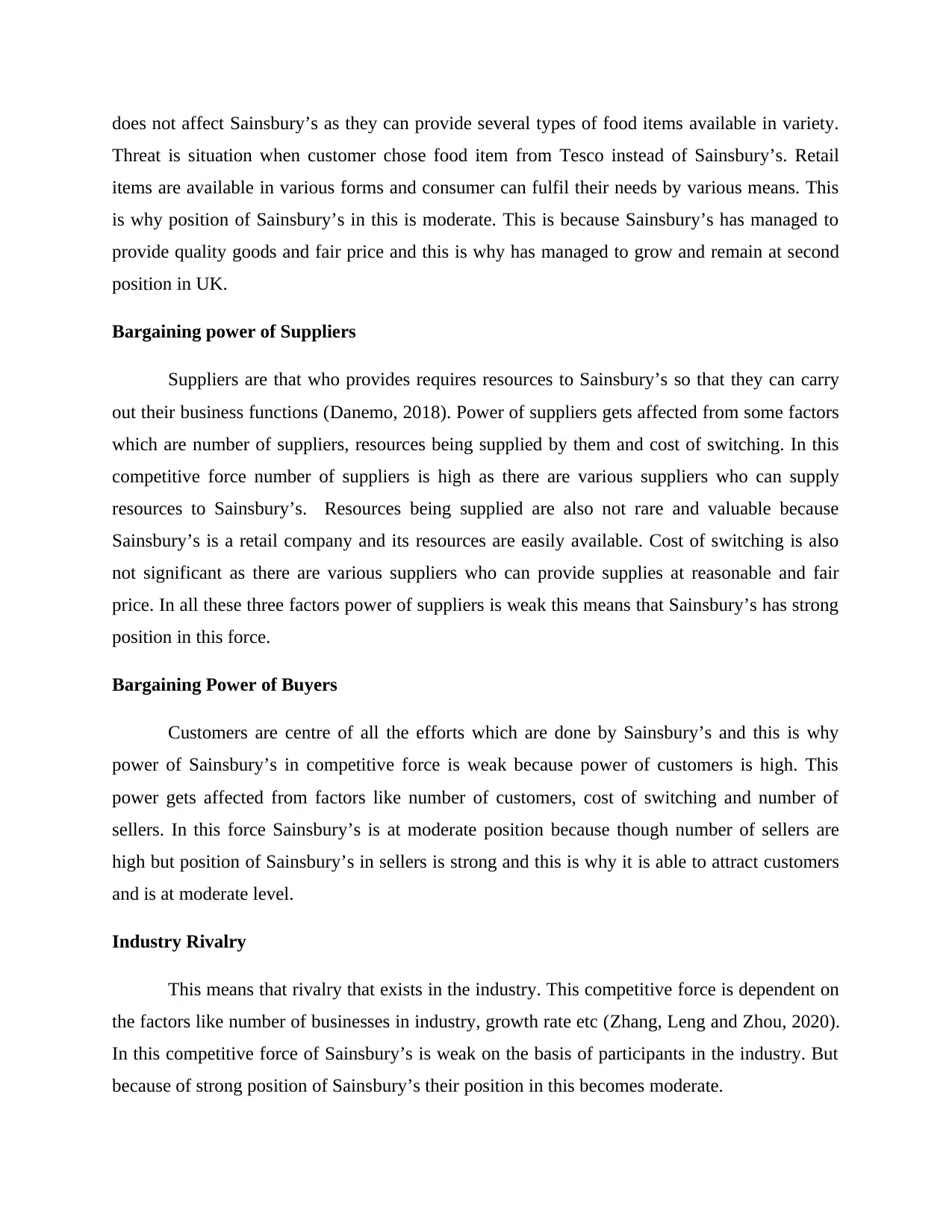
does not affect Sainsbury’s as they can provide several types of food items available in variety.
Threat is situation when customer chose food item from Tesco instead of Sainsbury’s. Retail
items are available in various forms and consumer can fulfil their needs by various means. This
is why position of Sainsbury’s in this is moderate. This is because Sainsbury’s has managed to
provide quality goods and fair price and this is why has managed to grow and remain at second
position in UK.
Bargaining power of Suppliers
Suppliers are that who provides requires resources to Sainsbury’s so that they can carry
out their business functions (Danemo, 2018). Power of suppliers gets affected from some factors
which are number of suppliers, resources being supplied by them and cost of switching. In this
competitive force number of suppliers is high as there are various suppliers who can supply
resources to Sainsbury’s. Resources being supplied are also not rare and valuable because
Sainsbury’s is a retail company and its resources are easily available. Cost of switching is also
not significant as there are various suppliers who can provide supplies at reasonable and fair
price. In all these three factors power of suppliers is weak this means that Sainsbury’s has strong
position in this force.
Bargaining Power of Buyers
Customers are centre of all the efforts which are done by Sainsbury’s and this is why
power of Sainsbury’s in competitive force is weak because power of customers is high. This
power gets affected from factors like number of customers, cost of switching and number of
sellers. In this force Sainsbury’s is at moderate position because though number of sellers are
high but position of Sainsbury’s in sellers is strong and this is why it is able to attract customers
and is at moderate level.
Industry Rivalry
This means that rivalry that exists in the industry. This competitive force is dependent on
the factors like number of businesses in industry, growth rate etc (Zhang, Leng and Zhou, 2020).
In this competitive force of Sainsbury’s is weak on the basis of participants in the industry. But
because of strong position of Sainsbury’s their position in this becomes moderate.
Threat is situation when customer chose food item from Tesco instead of Sainsbury’s. Retail
items are available in various forms and consumer can fulfil their needs by various means. This
is why position of Sainsbury’s in this is moderate. This is because Sainsbury’s has managed to
provide quality goods and fair price and this is why has managed to grow and remain at second
position in UK.
Bargaining power of Suppliers
Suppliers are that who provides requires resources to Sainsbury’s so that they can carry
out their business functions (Danemo, 2018). Power of suppliers gets affected from some factors
which are number of suppliers, resources being supplied by them and cost of switching. In this
competitive force number of suppliers is high as there are various suppliers who can supply
resources to Sainsbury’s. Resources being supplied are also not rare and valuable because
Sainsbury’s is a retail company and its resources are easily available. Cost of switching is also
not significant as there are various suppliers who can provide supplies at reasonable and fair
price. In all these three factors power of suppliers is weak this means that Sainsbury’s has strong
position in this force.
Bargaining Power of Buyers
Customers are centre of all the efforts which are done by Sainsbury’s and this is why
power of Sainsbury’s in competitive force is weak because power of customers is high. This
power gets affected from factors like number of customers, cost of switching and number of
sellers. In this force Sainsbury’s is at moderate position because though number of sellers are
high but position of Sainsbury’s in sellers is strong and this is why it is able to attract customers
and is at moderate level.
Industry Rivalry
This means that rivalry that exists in the industry. This competitive force is dependent on
the factors like number of businesses in industry, growth rate etc (Zhang, Leng and Zhou, 2020).
In this competitive force of Sainsbury’s is weak on the basis of participants in the industry. But
because of strong position of Sainsbury’s their position in this becomes moderate.
Paraphrase This Document
Need a fresh take? Get an instant paraphrase of this document with our AI Paraphraser
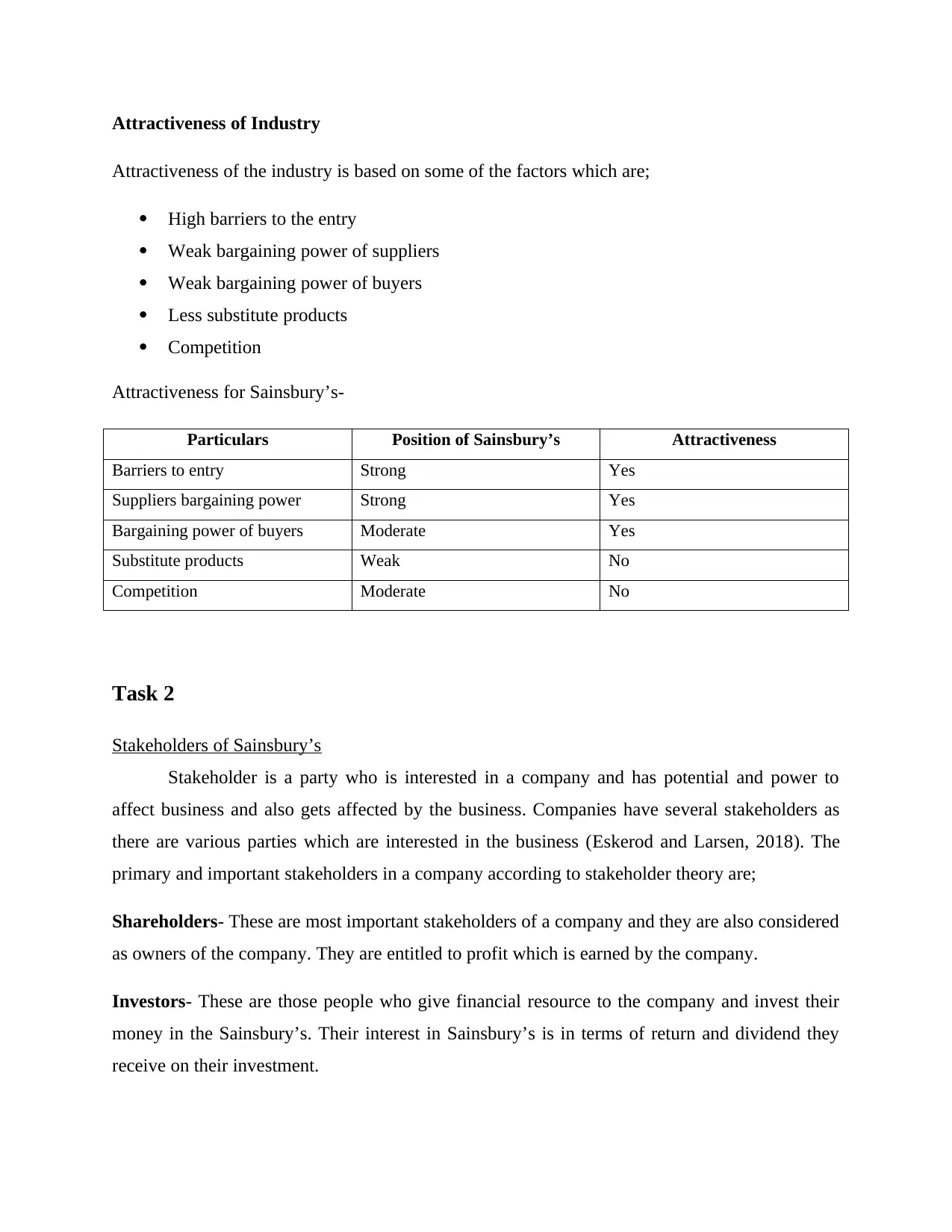
Attractiveness of Industry
Attractiveness of the industry is based on some of the factors which are;
High barriers to the entry
Weak bargaining power of suppliers
Weak bargaining power of buyers
Less substitute products
Competition
Attractiveness for Sainsbury’s-
Particulars Position of Sainsbury’s Attractiveness
Barriers to entry Strong Yes
Suppliers bargaining power Strong Yes
Bargaining power of buyers Moderate Yes
Substitute products Weak No
Competition Moderate No
Task 2
Stakeholders of Sainsbury’s
Stakeholder is a party who is interested in a company and has potential and power to
affect business and also gets affected by the business. Companies have several stakeholders as
there are various parties which are interested in the business (Eskerod and Larsen, 2018). The
primary and important stakeholders in a company according to stakeholder theory are;
Shareholders- These are most important stakeholders of a company and they are also considered
as owners of the company. They are entitled to profit which is earned by the company.
Investors- These are those people who give financial resource to the company and invest their
money in the Sainsbury’s. Their interest in Sainsbury’s is in terms of return and dividend they
receive on their investment.
Attractiveness of the industry is based on some of the factors which are;
High barriers to the entry
Weak bargaining power of suppliers
Weak bargaining power of buyers
Less substitute products
Competition
Attractiveness for Sainsbury’s-
Particulars Position of Sainsbury’s Attractiveness
Barriers to entry Strong Yes
Suppliers bargaining power Strong Yes
Bargaining power of buyers Moderate Yes
Substitute products Weak No
Competition Moderate No
Task 2
Stakeholders of Sainsbury’s
Stakeholder is a party who is interested in a company and has potential and power to
affect business and also gets affected by the business. Companies have several stakeholders as
there are various parties which are interested in the business (Eskerod and Larsen, 2018). The
primary and important stakeholders in a company according to stakeholder theory are;
Shareholders- These are most important stakeholders of a company and they are also considered
as owners of the company. They are entitled to profit which is earned by the company.
Investors- These are those people who give financial resource to the company and invest their
money in the Sainsbury’s. Their interest in Sainsbury’s is in terms of return and dividend they
receive on their investment.
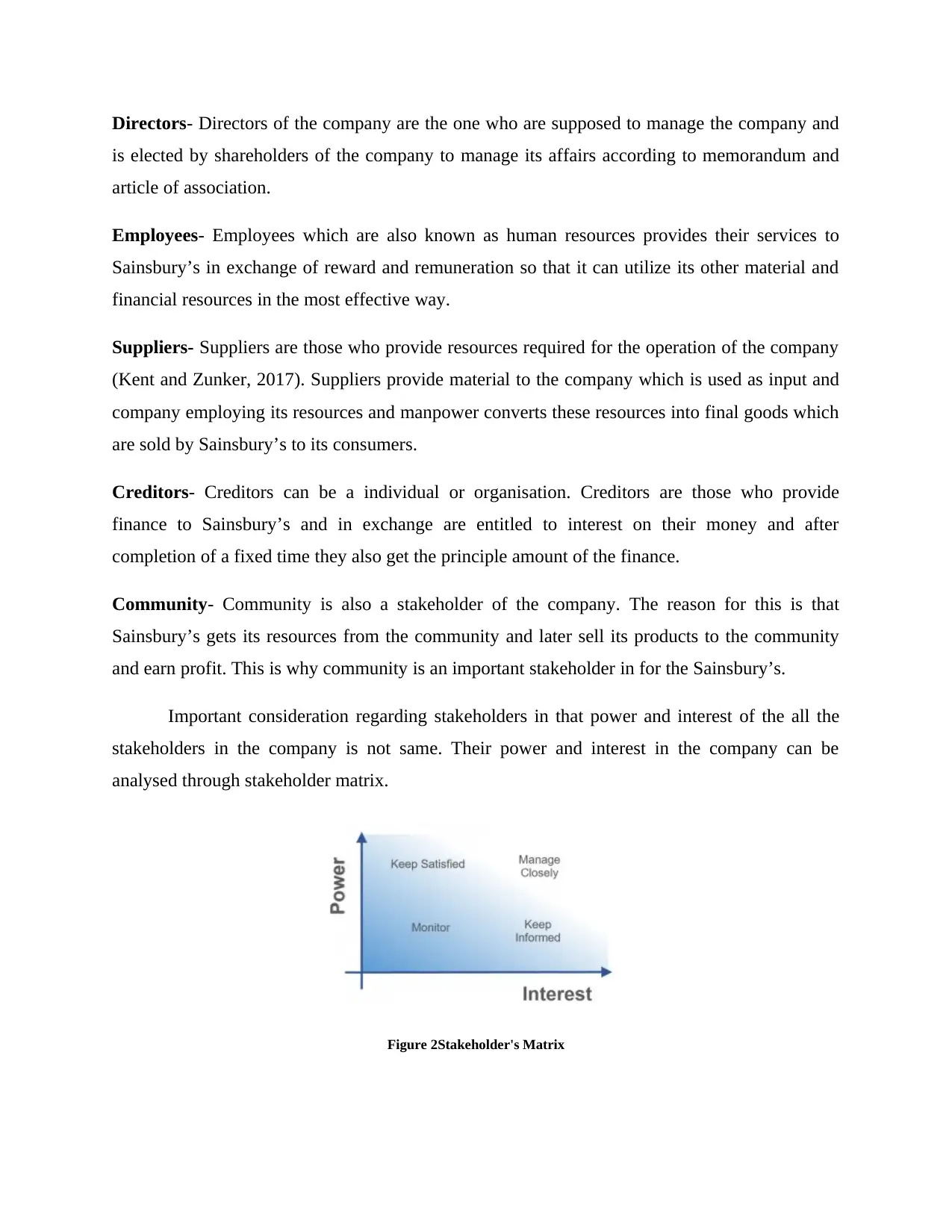
Directors- Directors of the company are the one who are supposed to manage the company and
is elected by shareholders of the company to manage its affairs according to memorandum and
article of association.
Employees- Employees which are also known as human resources provides their services to
Sainsbury’s in exchange of reward and remuneration so that it can utilize its other material and
financial resources in the most effective way.
Suppliers- Suppliers are those who provide resources required for the operation of the company
(Kent and Zunker, 2017). Suppliers provide material to the company which is used as input and
company employing its resources and manpower converts these resources into final goods which
are sold by Sainsbury’s to its consumers.
Creditors- Creditors can be a individual or organisation. Creditors are those who provide
finance to Sainsbury’s and in exchange are entitled to interest on their money and after
completion of a fixed time they also get the principle amount of the finance.
Community- Community is also a stakeholder of the company. The reason for this is that
Sainsbury’s gets its resources from the community and later sell its products to the community
and earn profit. This is why community is an important stakeholder in for the Sainsbury’s.
Important consideration regarding stakeholders in that power and interest of the all the
stakeholders in the company is not same. Their power and interest in the company can be
analysed through stakeholder matrix.
Figure 2Stakeholder's Matrix
is elected by shareholders of the company to manage its affairs according to memorandum and
article of association.
Employees- Employees which are also known as human resources provides their services to
Sainsbury’s in exchange of reward and remuneration so that it can utilize its other material and
financial resources in the most effective way.
Suppliers- Suppliers are those who provide resources required for the operation of the company
(Kent and Zunker, 2017). Suppliers provide material to the company which is used as input and
company employing its resources and manpower converts these resources into final goods which
are sold by Sainsbury’s to its consumers.
Creditors- Creditors can be a individual or organisation. Creditors are those who provide
finance to Sainsbury’s and in exchange are entitled to interest on their money and after
completion of a fixed time they also get the principle amount of the finance.
Community- Community is also a stakeholder of the company. The reason for this is that
Sainsbury’s gets its resources from the community and later sell its products to the community
and earn profit. This is why community is an important stakeholder in for the Sainsbury’s.
Important consideration regarding stakeholders in that power and interest of the all the
stakeholders in the company is not same. Their power and interest in the company can be
analysed through stakeholder matrix.
Figure 2Stakeholder's Matrix
⊘ This is a preview!⊘
Do you want full access?
Subscribe today to unlock all pages.

Trusted by 1+ million students worldwide
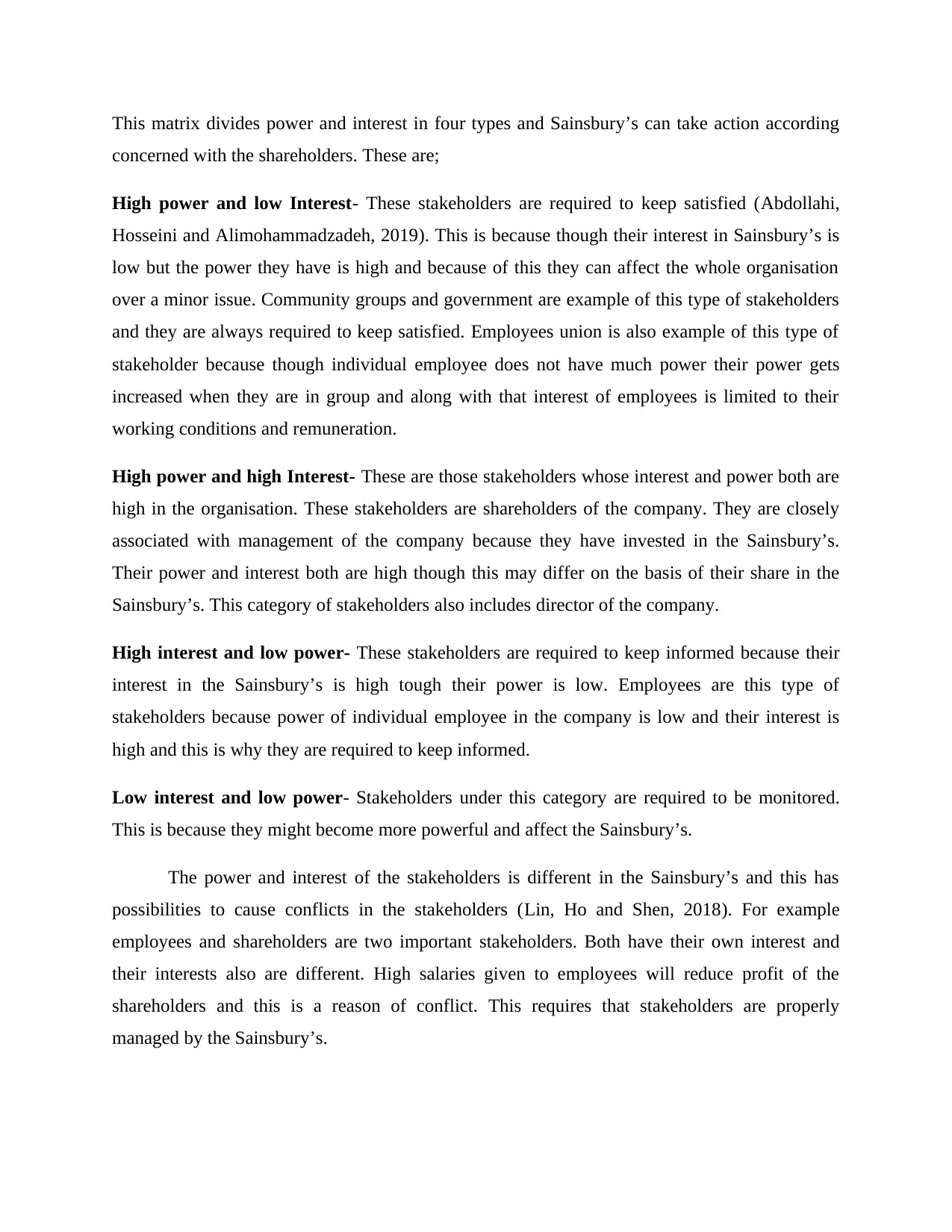
This matrix divides power and interest in four types and Sainsbury’s can take action according
concerned with the shareholders. These are;
High power and low Interest- These stakeholders are required to keep satisfied (Abdollahi,
Hosseini and Alimohammadzadeh, 2019). This is because though their interest in Sainsbury’s is
low but the power they have is high and because of this they can affect the whole organisation
over a minor issue. Community groups and government are example of this type of stakeholders
and they are always required to keep satisfied. Employees union is also example of this type of
stakeholder because though individual employee does not have much power their power gets
increased when they are in group and along with that interest of employees is limited to their
working conditions and remuneration.
High power and high Interest- These are those stakeholders whose interest and power both are
high in the organisation. These stakeholders are shareholders of the company. They are closely
associated with management of the company because they have invested in the Sainsbury’s.
Their power and interest both are high though this may differ on the basis of their share in the
Sainsbury’s. This category of stakeholders also includes director of the company.
High interest and low power- These stakeholders are required to keep informed because their
interest in the Sainsbury’s is high tough their power is low. Employees are this type of
stakeholders because power of individual employee in the company is low and their interest is
high and this is why they are required to keep informed.
Low interest and low power- Stakeholders under this category are required to be monitored.
This is because they might become more powerful and affect the Sainsbury’s.
The power and interest of the stakeholders is different in the Sainsbury’s and this has
possibilities to cause conflicts in the stakeholders (Lin, Ho and Shen, 2018). For example
employees and shareholders are two important stakeholders. Both have their own interest and
their interests also are different. High salaries given to employees will reduce profit of the
shareholders and this is a reason of conflict. This requires that stakeholders are properly
managed by the Sainsbury’s.
concerned with the shareholders. These are;
High power and low Interest- These stakeholders are required to keep satisfied (Abdollahi,
Hosseini and Alimohammadzadeh, 2019). This is because though their interest in Sainsbury’s is
low but the power they have is high and because of this they can affect the whole organisation
over a minor issue. Community groups and government are example of this type of stakeholders
and they are always required to keep satisfied. Employees union is also example of this type of
stakeholder because though individual employee does not have much power their power gets
increased when they are in group and along with that interest of employees is limited to their
working conditions and remuneration.
High power and high Interest- These are those stakeholders whose interest and power both are
high in the organisation. These stakeholders are shareholders of the company. They are closely
associated with management of the company because they have invested in the Sainsbury’s.
Their power and interest both are high though this may differ on the basis of their share in the
Sainsbury’s. This category of stakeholders also includes director of the company.
High interest and low power- These stakeholders are required to keep informed because their
interest in the Sainsbury’s is high tough their power is low. Employees are this type of
stakeholders because power of individual employee in the company is low and their interest is
high and this is why they are required to keep informed.
Low interest and low power- Stakeholders under this category are required to be monitored.
This is because they might become more powerful and affect the Sainsbury’s.
The power and interest of the stakeholders is different in the Sainsbury’s and this has
possibilities to cause conflicts in the stakeholders (Lin, Ho and Shen, 2018). For example
employees and shareholders are two important stakeholders. Both have their own interest and
their interests also are different. High salaries given to employees will reduce profit of the
shareholders and this is a reason of conflict. This requires that stakeholders are properly
managed by the Sainsbury’s.
Paraphrase This Document
Need a fresh take? Get an instant paraphrase of this document with our AI Paraphraser
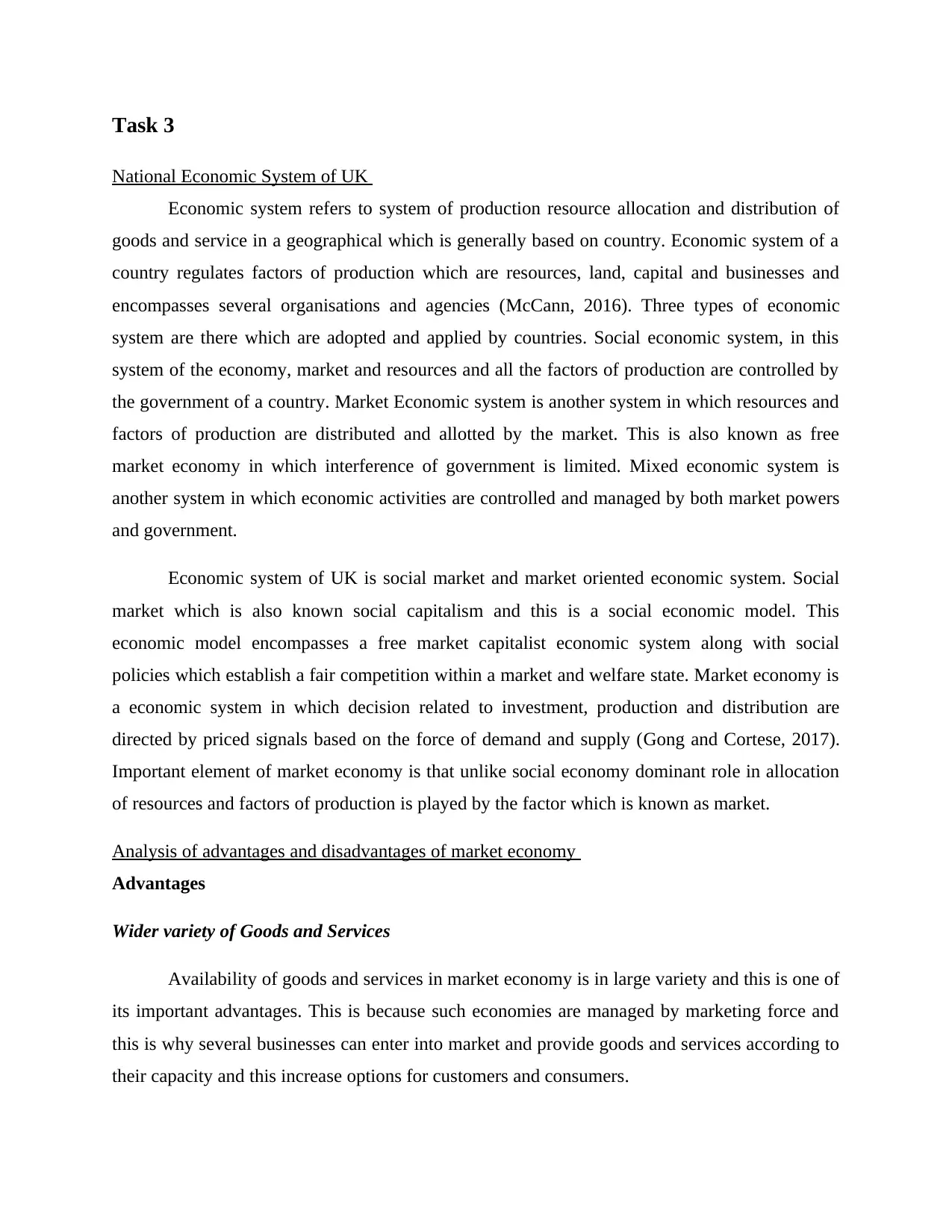
Task 3
National Economic System of UK
Economic system refers to system of production resource allocation and distribution of
goods and service in a geographical which is generally based on country. Economic system of a
country regulates factors of production which are resources, land, capital and businesses and
encompasses several organisations and agencies (McCann, 2016). Three types of economic
system are there which are adopted and applied by countries. Social economic system, in this
system of the economy, market and resources and all the factors of production are controlled by
the government of a country. Market Economic system is another system in which resources and
factors of production are distributed and allotted by the market. This is also known as free
market economy in which interference of government is limited. Mixed economic system is
another system in which economic activities are controlled and managed by both market powers
and government.
Economic system of UK is social market and market oriented economic system. Social
market which is also known social capitalism and this is a social economic model. This
economic model encompasses a free market capitalist economic system along with social
policies which establish a fair competition within a market and welfare state. Market economy is
a economic system in which decision related to investment, production and distribution are
directed by priced signals based on the force of demand and supply (Gong and Cortese, 2017).
Important element of market economy is that unlike social economy dominant role in allocation
of resources and factors of production is played by the factor which is known as market.
Analysis of advantages and disadvantages of market economy
Advantages
Wider variety of Goods and Services
Availability of goods and services in market economy is in large variety and this is one of
its important advantages. This is because such economies are managed by marketing force and
this is why several businesses can enter into market and provide goods and services according to
their capacity and this increase options for customers and consumers.
National Economic System of UK
Economic system refers to system of production resource allocation and distribution of
goods and service in a geographical which is generally based on country. Economic system of a
country regulates factors of production which are resources, land, capital and businesses and
encompasses several organisations and agencies (McCann, 2016). Three types of economic
system are there which are adopted and applied by countries. Social economic system, in this
system of the economy, market and resources and all the factors of production are controlled by
the government of a country. Market Economic system is another system in which resources and
factors of production are distributed and allotted by the market. This is also known as free
market economy in which interference of government is limited. Mixed economic system is
another system in which economic activities are controlled and managed by both market powers
and government.
Economic system of UK is social market and market oriented economic system. Social
market which is also known social capitalism and this is a social economic model. This
economic model encompasses a free market capitalist economic system along with social
policies which establish a fair competition within a market and welfare state. Market economy is
a economic system in which decision related to investment, production and distribution are
directed by priced signals based on the force of demand and supply (Gong and Cortese, 2017).
Important element of market economy is that unlike social economy dominant role in allocation
of resources and factors of production is played by the factor which is known as market.
Analysis of advantages and disadvantages of market economy
Advantages
Wider variety of Goods and Services
Availability of goods and services in market economy is in large variety and this is one of
its important advantages. This is because such economies are managed by marketing force and
this is why several businesses can enter into market and provide goods and services according to
their capacity and this increase options for customers and consumers.
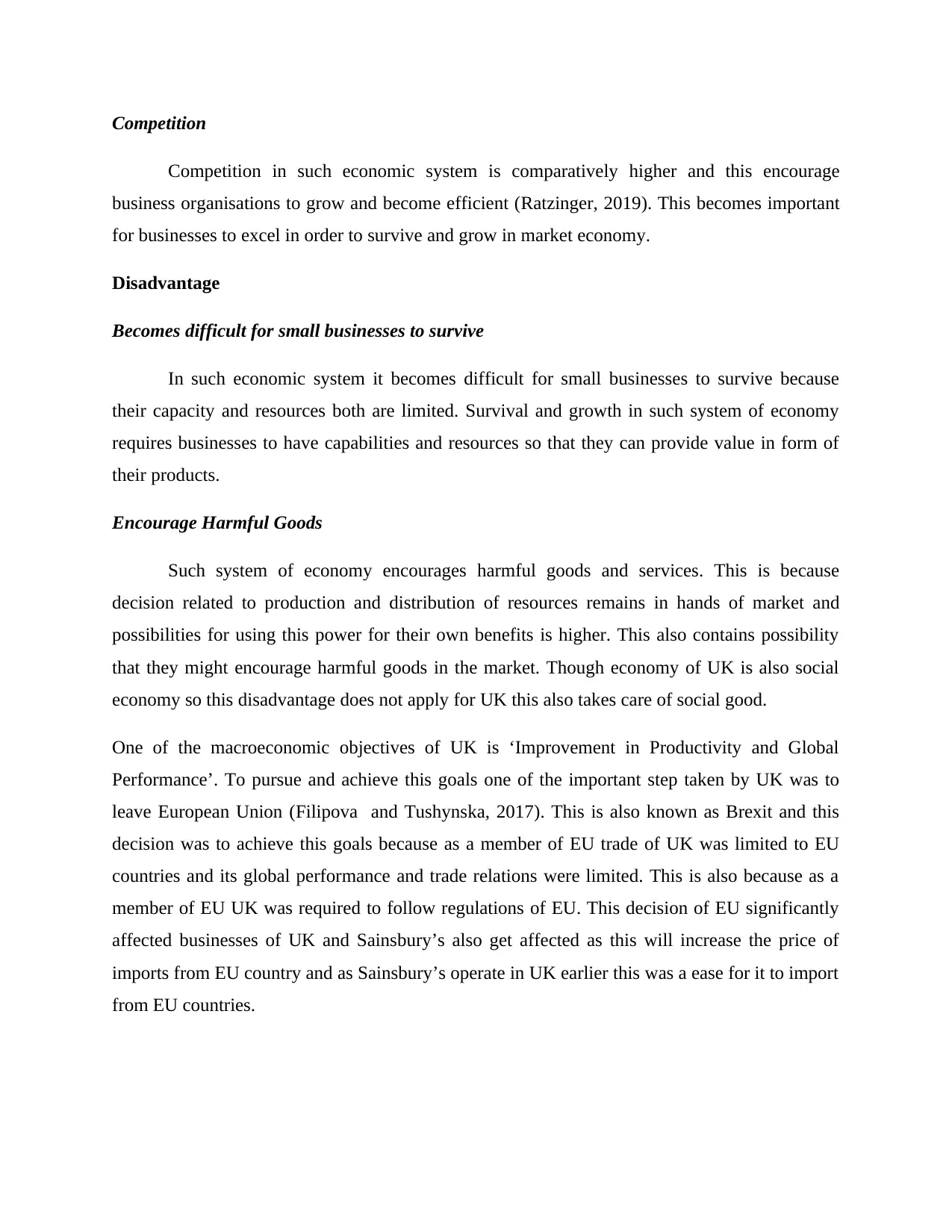
Competition
Competition in such economic system is comparatively higher and this encourage
business organisations to grow and become efficient (Ratzinger, 2019). This becomes important
for businesses to excel in order to survive and grow in market economy.
Disadvantage
Becomes difficult for small businesses to survive
In such economic system it becomes difficult for small businesses to survive because
their capacity and resources both are limited. Survival and growth in such system of economy
requires businesses to have capabilities and resources so that they can provide value in form of
their products.
Encourage Harmful Goods
Such system of economy encourages harmful goods and services. This is because
decision related to production and distribution of resources remains in hands of market and
possibilities for using this power for their own benefits is higher. This also contains possibility
that they might encourage harmful goods in the market. Though economy of UK is also social
economy so this disadvantage does not apply for UK this also takes care of social good.
One of the macroeconomic objectives of UK is ‘Improvement in Productivity and Global
Performance’. To pursue and achieve this goals one of the important step taken by UK was to
leave European Union (Filipova and Tushynska, 2017). This is also known as Brexit and this
decision was to achieve this goals because as a member of EU trade of UK was limited to EU
countries and its global performance and trade relations were limited. This is also because as a
member of EU UK was required to follow regulations of EU. This decision of EU significantly
affected businesses of UK and Sainsbury’s also get affected as this will increase the price of
imports from EU country and as Sainsbury’s operate in UK earlier this was a ease for it to import
from EU countries.
Competition in such economic system is comparatively higher and this encourage
business organisations to grow and become efficient (Ratzinger, 2019). This becomes important
for businesses to excel in order to survive and grow in market economy.
Disadvantage
Becomes difficult for small businesses to survive
In such economic system it becomes difficult for small businesses to survive because
their capacity and resources both are limited. Survival and growth in such system of economy
requires businesses to have capabilities and resources so that they can provide value in form of
their products.
Encourage Harmful Goods
Such system of economy encourages harmful goods and services. This is because
decision related to production and distribution of resources remains in hands of market and
possibilities for using this power for their own benefits is higher. This also contains possibility
that they might encourage harmful goods in the market. Though economy of UK is also social
economy so this disadvantage does not apply for UK this also takes care of social good.
One of the macroeconomic objectives of UK is ‘Improvement in Productivity and Global
Performance’. To pursue and achieve this goals one of the important step taken by UK was to
leave European Union (Filipova and Tushynska, 2017). This is also known as Brexit and this
decision was to achieve this goals because as a member of EU trade of UK was limited to EU
countries and its global performance and trade relations were limited. This is also because as a
member of EU UK was required to follow regulations of EU. This decision of EU significantly
affected businesses of UK and Sainsbury’s also get affected as this will increase the price of
imports from EU country and as Sainsbury’s operate in UK earlier this was a ease for it to import
from EU countries.
⊘ This is a preview!⊘
Do you want full access?
Subscribe today to unlock all pages.

Trusted by 1+ million students worldwide
1 out of 15
Related Documents
Your All-in-One AI-Powered Toolkit for Academic Success.
+13062052269
info@desklib.com
Available 24*7 on WhatsApp / Email
![[object Object]](/_next/static/media/star-bottom.7253800d.svg)
Unlock your academic potential
Copyright © 2020–2025 A2Z Services. All Rights Reserved. Developed and managed by ZUCOL.





